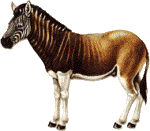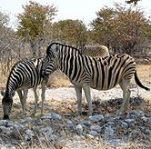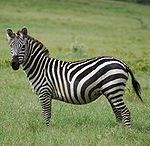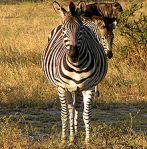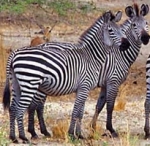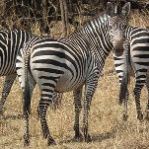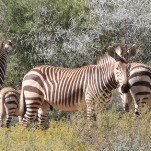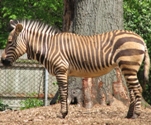The Zebra is a hoofed animal with black and white stripes all over its body. It has a horse-like body with a short, erect mane and a tufted tail. Their stripes come in different patterns unique to each individual.
There are three species of zebras: the Plains zebra, the Grevy’s zebra, and the Mountain zebra.
The common plains zebra is about 1.3 m at the shoulder with a body ranging from 2–2.6 m long with a 0.5m tail. It can weigh up to 350 kg, males being slightly bigger than females.
It was previously believed that zebras were white animals with black stripes since some zebras have white underbellies. Embryological evidence, however, shows that the animal’s background color is black and the white stripes and bellies are additions.
Zebras have excellent eyesight. It is believed that they can see in color. Like most ungulates, the zebra has its eyes on the sides of its head, giving it a wide field of view. Zebras also have night vision, although not as advanced as that of most of their predators.
Zebras feed almost entirely on grasses, but may occasionally eat shrubs, herbs, twigs, leaves, and bark. Their digestive systems allow them to subsist on diets of lower nutritional quality than that necessary for other herbivores. Some zebra can go without water for up to five days. Zebra often walk miles to drink water.
Zebras communicate with each other with high pitched barks and whinnying. A zebra’s ears signify its mood. When a zebra is in a calm, tense or friendly mood, its ears stand erect. When it is frightening, its ears are pushed forward. When angry, the ears are pulled backward.
Below are listed a few types of zebra
Plains Zebra
Table of Contents
The plains zebra also known as the common zebra or Burchell’s zebra, is the most common and geographically widespread species of zebra. It ranges from the south of Ethiopia through East Africa to as far south as Angola and eastern South Africa.
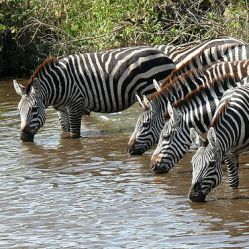 They live in highly organized social groups. Their herds have a single stallion and a few mares and foals which he oversees.
They live in highly organized social groups. Their herds have a single stallion and a few mares and foals which he oversees.
The plains zebra is mid-sized, smaller on average than the other two zebra species, and thick-bodied with relatively short legs. Adults of both sexes can stand from 1.1 to 1.47 m high at the shoulder, are 2 to 2.5 m long, not counting a 50 cm tall, and weigh 175 to 387 kg.
Mountain Zebra
The Mountain Zebra is a threatened species of equid native to south-western Angola, Namibia, and South Africa. There are two subspecies of mountain zebra the Hartmann’s Mountain Zebra and the Cape Mountain Zebra.
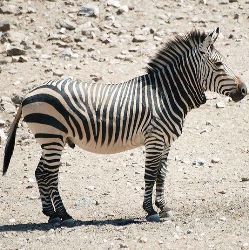 The stripe can be black and white or dark brown and white. Their stripes cover their whole bodies except for their bellies. The Mountain zebra also has a dewlap.
The stripe can be black and white or dark brown and white. Their stripes cover their whole bodies except for their bellies. The Mountain zebra also has a dewlap.
Adult mountain zebras have a head-and-body length of 2.1 to 2.7 m and a tail of 40 to 55 cm long. Shoulder height ranges from 1.1 to 1.5 m. They weigh from 204 to 372 kg.
Grévy’s zebra
The Grévy’s zebra also known as the Imperial zebra, is the largest extant wild equid and one of three species of zebra. The Grévy’s zebra is found in Kenya and Ethiopia. Compared with other zebras, it is tall, has large ears, and its stripes are narrower. It is more ass-like in appearance as compared to other zebras, which are more horse-like.
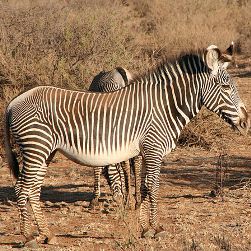 Grévy’s zebra is the largest of all wild equines. It is 2.5–2.75 m from head to tail with a 38–75 cm tail, and stands 1.45–1.60 m high at the shoulder. These zebras weigh 350–450 kg.
Grévy’s zebra is the largest of all wild equines. It is 2.5–2.75 m from head to tail with a 38–75 cm tail, and stands 1.45–1.60 m high at the shoulder. These zebras weigh 350–450 kg.
The stripes are narrow and close-set, being broader on the neck, and they extend to the hooves. The belly and the area around the base of the tail lack stripes.
More Zebra Types and Photos
